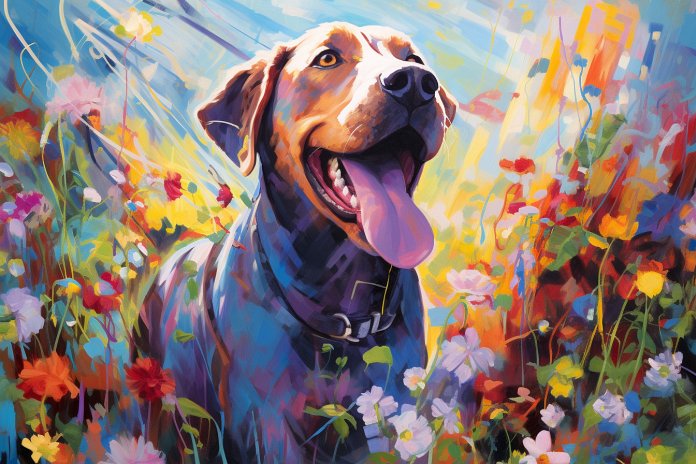
Dogs have an incredible sense of smell, which is up to 100,000 times more powerful than ours. They can sniff out even the faintest of odors. In this article, we will explore what dogs can smell, why their noses are so powerful, and how we can put their sense of smell to good use.
Signs Your Dog has Picked up a Scent
When dogs detect an interesting smell, they may become focused and determined to track it down. It is important to let them explore and follow scents during walks, as this is how they explore the world. Signs that your dog has picked up a scent include holding their head high, thrusting their nose into the air, and following the source of the smell. Different breeds may have different signs, such as standing still or pointing in the direction of the smell.
Body Language
When dogs detect a scent they want to follow, their body language can indicate their excitement and focus. Signs include staring, being alert, barking, head tilting, and sniffing. Other signs may include holding their head high, turning their head to follow the scent, ignoring commands, rapid breathing, and pointing, barking, or pawing at the source of the smell.
History of Dogs’ Amazing Sense of Smell
Dogs’ sense of smell has been crucial for their survival and their role as working companions to humans. They have been selectively bred for thousands of years to enhance their ability to track prey, detect danger, and perform various tasks. Dogs have been trained to detect narcotics, explosives, cancer in humans, and even whale poop. There are still many potential applications for their nose-power that we have yet to discover.
The Science of a Dog’s Sense of Smell
Dogs’ remarkable sense of smell is due to their biology. Their wet, spongy noses are ideal for capturing scents, and their nostrils can operate independently to detect where a smell is coming from. Dogs have up to 300 million olfactory receptors in their noses, compared to our 5 or 6 million. The part of their brain that analyzes smells is proportionally much larger than ours. Dogs can do incredible things with their noses, such as sensing fear or anxiety in humans.
Training Your Dog’s Sense of Smell
You can encourage your dog to use their sense of smell by teaching them to search for treats or toys you’ve hidden. Start with easy hiding places and gradually increase the difficulty. If your dog enjoys scent work, you can explore sports like K9 Nose Work, Earthdog, or Tracking. Remember to keep the training sessions fun, end on a high note, and stay patient.
By harnessing their incredible sense of smell, we can provide mental stimulation and fulfillment for our furry companions.
“Unlock the incredible power of your dog’s nose and watch them sniff out the world in awe-inspiring ways.”

Tips & Things to Know
1️⃣ Allow your dog to follow scents during walks: Dogs enjoy exploring the world through their sense of smell, so let them stop and sniff during walks. It’s a reward for them and allows them to experience the environment fully.
2️⃣ Recognize the signs that your dog has detected a scent: Look for body language cues such as a raised head, nose in the air, or turning their head to follow a scent. Different breeds may have specific behaviors, like pointing or barking, that indicate they have found an interesting smell.
3️⃣ Harness your dog’s sense of smell through training: You can engage your dog’s sense of smell by teaching them to search for treats or toys. Start with simple hiding places and gradually increase the difficulty. Consider participating in scent work sports like K9 Nose Work or Tracking to provide mental stimulation and exercise for your dog.
Frequently Asked Questions, Answered ✅
1. What makes dogs’ sense of smell so powerful?
Answer: Dogs have up to 100,000 times more powerful noses than humans and possess up to 300 million olfactory receptors, along with a larger brain region dedicated to analyzing smells.
2. How can you tell if your dog has picked up a scent?
Answer: Signs include a head held high, nose in the air, turning head to follow the scent, rapid inhaling and exhaling, and specific behaviors like pointing, barking, or pawing at the source of the smell.
3. How has humans’ selective breeding enhanced dogs’ sense of smell?
Answer: Humans have selectively bred dogs for thousands of years to work alongside them, primarily as hunters and guardians. A strong sense of smell has been critical for dogs to perform these roles effectively.
4. Can dogs detect emotions in humans through their sense of smell?
Answer: Yes, dogs can sense fear or anxiety in humans by detecting variations in heart rate and blood flow that lead to chemical changes on the skin’s surface.
5. How can you harness your dog’s sense of smell for training?
Answer: You can encourage your dog’s scenting ability by teaching them to search for treats or their favorite toy. You can also consider participating in scent work sports like K9 Nose Work, Earthdog, or Tracking to provide a workout for their sense of smell.